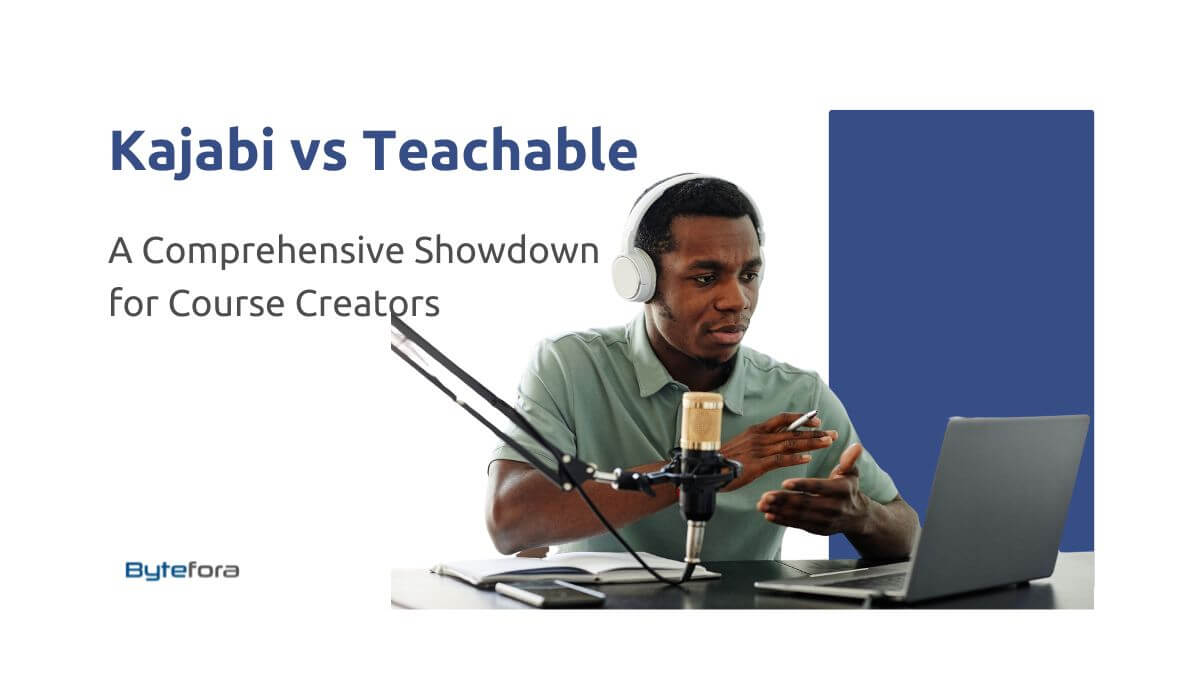Are you torn in the Kajabi vs Teachable debate? In this comprehensive showdown, we dive deep into the pros and cons of each, helping you navigate the myriad of features, pricing, and user experiences. Whether you’re a seasoned educator or just starting, understanding the nuances of Kajabi and Teachable is crucial in choosing the right platform for your educational venture. Let’s embark on this journey together, uncovering the key elements that will guide you to make an informed decision for your online course success.
Table of Contents
Overview of Online Course Platforms
Understanding the Role of Online Course Platforms
Before delving into the specifics of Kajabi and Teachable, let’s first understand what online course platforms offer and why they are essential for digital educators. These platforms are more than just repositories for content; they are dynamic environments where educators can create, manage, and market their courses. They also provide interaction, assessment, and feedback tools, making the online learning experience rich and engaging. Choosing the right platform is crucial as it forms the backbone of your online teaching business, impacting everything from student engagement to revenue generation.

Evolution of E-learning
The evolution of e-learning platforms has transformed how we approach education, making it more accessible and diverse. Gone are the days when learning was confined to physical classrooms and fixed schedules. Modern e-learning platforms offer unparalleled flexibility and reach, allowing educators and learners to connect from anywhere in the world. This shift has also democratized education, providing opportunities for a broader audience to learn new skills, pursue hobbies, or advance their careers. As these platforms evolve, they continue to offer more sophisticated tools and features, shaping the future of education.
Kajabi – An Overview
Introduction to Kajabi
Kajabi emerges as a powerful, all-in-one online business platform established in 2010. Renowned for its extensive suite of tools, Kajabi excels in providing a comprehensive solution for course creators and digital entrepreneurs. Unlike Teachable, which focuses primarily on course creation, Kajabi extends its services to include website building, advanced email marketing, and robust sales funnel creation. This makes Kajabi not just a course platform but a complete business ecosystem.
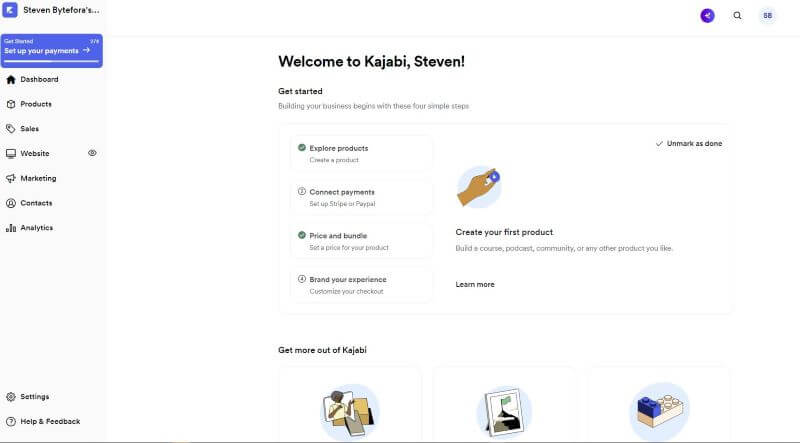
Key Features of Kajabi
Kajabi distinguishes itself with a robust set of features designed to cater to every aspect of online course creation and marketing.
- Course Creation and Management: Kajabi allows for intricate course creation with options for multimedia lectures, quizzes, and coaching sessions. Unlike Teachable, which keeps its course creation straightforward, Kajabi provides more advanced customization options, allowing for a more tailored educational experience.
- Marketing and Sales Tools: Where Kajabi really shines and sets itself apart from Teachable is in its integrated marketing tools. It offers automated email campaigns, sales funnels, and built-in blogging capabilities. This holistic approach is particularly beneficial for creators who want a unified platform for both creating courses and executing sophisticated marketing strategies.
- Website Building: Beyond course creation, Kajabi enables users to build a fully functional website, which is a stark contrast to Teachable’s more course-centric approach. This feature includes customizable themes and the ability to host webinars and podcasts, further expanding a creator’s online presence.
- Analytics and Reporting: Kajabi provides detailed analytics and reporting tools, giving creators insight into course performance, sales data, and student engagement. This data is crucial for continuously refining and improving the online learning experience.
While Teachable focuses on simplicity and ease of use, Kajabi offers a more feature-rich environment, catering to those looking for an all-encompassing platform to build and grow their online education business. The decision between Kajabi and Teachable ultimately hinges on your specific needs, whether you seek a straightforward course creation tool or a comprehensive business solution.
Teachable – An Overview
Introduction to Teachable
Teachable presents a compelling case for creators who prioritize ease of use and straightforward course creation. Launched in 2014, Teachable has quickly garnered attention in the online course platform market for its focus on accessibility and user-friendly features. While Kajabi offers a broad range of tools for course creators and entrepreneurs, Teachable stands out for its simplicity and focus on delivering an intuitive platform for educators and learners alike.
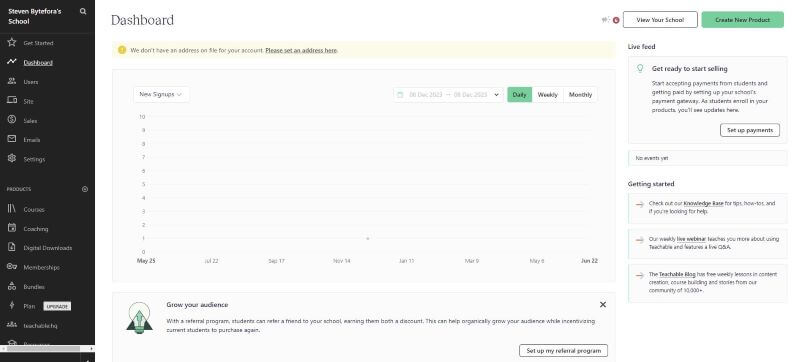
Key Features of Teachable
As we delve deeper into the Teachables vs Kajabi comparison, it becomes evident that Teachable’s strengths lie in its straightforward, no-frills approach to online course delivery.
- Ease of Course Creation: Teachable’s course builder is renowned for its simplicity. It enables creators to build and launch courses with minimal technical know-how. This contrasts with Kajabi’s more feature-rich but complex approach, making Teachable a go-to for beginners or those who seek a more streamlined process.
- Student Engagement Tools: Teachable focuses on creating an engaging learning experience with features like quizzes, course completion certificates, and integrated comment sections. These tools are designed to enhance the learning experience and keep students engaged, a vital aspect often overshadowed in Kajabi’s comprehensive business tools.
- Payment Processing and Analytics: With its straightforward payment processing system, Teachable makes it easy for creators to monetize their courses. Its analytics tools, while not as extensive as Kajabi’s, provide essential insights into course performance and student engagement.
- Customization and Branding: Teachable offers adequate customization options to maintain brand consistency across courses. However, compared to Kajabi, these options are more limited, focusing on ease of use rather than extensive customization.
Teachable positions itself as a user-friendly alternative in the Teachable vs Kajabi discussion, appealing to course creators who value simplicity and directness in course creation and management. It caters excellently to those starting in the digital education space or who prefer to avoid navigating the complexity of more comprehensive platforms like Kajabi.
In-Depth Feature Comparison
Course Creation and Management
the area of course creation and management is where we see a significant divergence in their offerings, catering to different creator needs and preferences.
Kajabi’s Approach to Course Creation
Kajabi provides a robust and sophisticated environment for course creation. It offers a wide array of features, including customizable course templates, advanced content uploading options, and interactive tools like quizzes and assessments. Additionally, Kajabi allows for the creation of membership sites and community forums, enhancing the learning experience and fostering student engagement. These features are ideal for creators who are looking for a comprehensive, all-in-one platform that goes beyond just course delivery.

Teachable’s Simplified Course Management
Conversely, Teachable takes a more streamlined approach. Its course builder is designed for ease of use, enabling creators to quickly set up courses without the need for extensive technical knowledge. Teachable’s strength lies in its intuitive drag-and-drop interface, straightforward content upload, and simple yet effective course organization tools. This simplicity makes Teachable a strong contender for those who prefer a more direct and less complex course management system.

Differences in Student Interaction and Feedback
Another critical aspect of the Kajabi and Teachable comparison is the way they handle student interaction and feedback. Kajabi offers automated engagement tools, such as email sequences triggered by student actions and detailed analytics to track student progress. Teachable, while providing essential tools for student engagement like quizzes and discussion forums, focuses more on the fundamental aspects of course delivery without the advanced automation of Kajabi.
Content Hosting and Security
Regarding content hosting and security, both Kajabi and Teachable offer reliable hosting services with a focus on content security and intellectual property protection. However, Kajabi provides more advanced options for content protection, such as secure video hosting and course-specific access controls, compared to Teachable’s more basic security features.
Marketing and Sales Tools
A critical component in the Kajabi and Teachable comparison lies in their marketing and sales tools, which are essential for the growth and success of any online course.
Kajabi’s Integrated Marketing Suite
Kajabi excels with its integrated marketing suite, a key differentiator in the Kajabi and Teachable debate. It offers a range of sophisticated tools, including automated email marketing campaigns, influential sales funnel builders, and advanced CRM (Customer Relationship Management) features. These tools allow creators to implement comprehensive marketing strategies directly within the platform. Kajabi’s ability to create and manage marketing funnels is particularly noteworthy, enabling users to guide potential students from initial awareness to final purchase seamlessly.

Teachable’s Basic Yet Effective Marketing Tools
Teachable, in contrast, provides more basic but still effective marketing tools. While it may lack the breadth of Kajabi’s marketing suite, Teachable offers essential features like affiliate marketing, coupon code generation, and promotional tools. These features are sufficient for course creators who are looking for straightforward ways to market their courses without the need for extensive, integrated marketing campaigns.
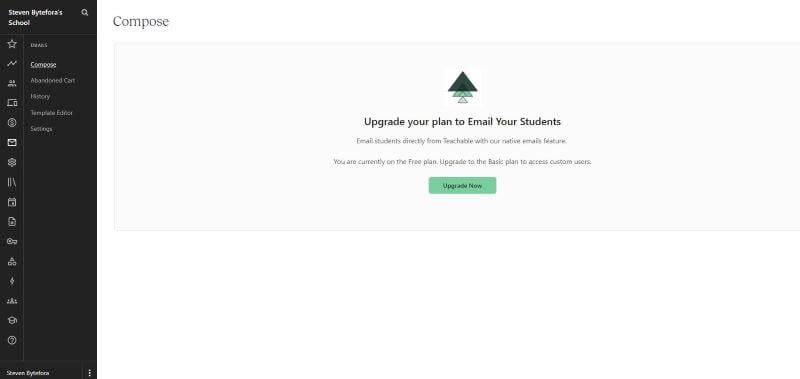
Sales and Checkout Experience
When comparing Kajabi and Teachable, the sales process and checkout experience are also crucial. Kajabi provides a highly customizable checkout process, allowing creators to optimize conversions with upsells and order bumps. This level of customization can significantly enhance sales potential. Teachable offers a streamlined checkout process, focusing on simplicity and user-friendliness, which can reduce friction for potential buyers but offers less customization than Kajabi.
Analytics and Performance Tracking
Both platforms offer analytics and performance tracking, but Kajabi’s analytics are more advanced, offering in-depth insights into sales, course engagement, and customer behavior. Teachable’s analytics, while simpler, still provide essential information such as course completion rates and revenue tracking.
User Interface and Experience
The user interface and experience play a pivotal role in the Kajabi or Teachable comparison, directly impacting how course creators and their students interact with the platform.
Kajabi’s Premium User Interface
Kajabi offers a sleek and modern user interface, reflecting its status as a premium, all-in-one platform in the Kajabi or Teachable debate. The platform’s dashboard is thoughtfully designed, providing easy access to various tools and features. However, the extensive range of features available on Kajabi can be overwhelming for beginners or those who prefer a more streamlined approach. For users looking for a sophisticated, feature-rich environment, Kajabi’s interface provides an excellent balance between functionality and aesthetics.
Teachable’s Focus on Simplicity
Teachable, on the other hand, prioritizes simplicity and ease of use. Its interface is clean and intuitive, making it easy for beginners to navigate. This focus on simplicity is evident in the platform’s straightforward dashboard and course creation tools, which are designed to minimize the learning curve for new users. Teachable’s approach is particularly appealing to those who value straightforwardness and ease of use over a wide array of features.
Course Navigation and Student Experience
Kajabi’s courses are well-structured, offering a high level of interactivity and engagement through various multimedia content options. Teachable, while more straightforward in design, also provides a smooth and practical course navigation experience for students, with a focus on content delivery and learner engagement.
Mobile Responsiveness and Accessibility
Both Kajabi and Teachable understand the importance of mobile responsiveness in today’s digital landscape. Each platform offers mobile-friendly interfaces, ensuring that courses are accessible on various devices. This is a vital aspect for creators and learners who prefer accessing content on the go.
Pricing and Value for Money
Understanding the Pricing Structures
Kajabi and Teachable offer various pricing tiers, each with its own features and limitations. Kajabi’s plans are generally higher in price, reflecting its extensive feature set and all-in-one approach. These plans are suited for those needing comprehensive tools for course creation, marketing, and sales tools. On the other hand, Teachable’s pricing is more accessible, especially for beginners or those with a limited budget. While less comprehensive than Kajabi’s, its plans offer a robust set of features for course creation and student engagement.
Analyzing the ROI for Course Creators
When considering the return on investment (ROI) for course creators, the Kajabi and Teachable comparison offers insightful perspectives on how each platform can impact your bottom line.

Kajabi’s Comprehensive Feature Set and ROI
Kajabi, with its all-in-one approach, offers a broad range of features that can significantly enhance the value you provide to your students. The platform’s advanced marketing tools, automation capabilities, and comprehensive course creation options can lead to higher engagement and sales, albeit at a higher cost. For creators who utilize these features effectively, Kajabi can offer a high ROI, especially if you’re looking to build a substantial online business that goes beyond selling courses to include memberships, coaching, and more.
Teachable’s Accessibility and ROI
Teachable’s more affordable pricing model and ease of use make it a compelling option for those starting or looking for simplicity. While it may lack some of the advanced features of Kajabi, Teachable’s straightforward approach to course creation and sales can lead to a good ROI for creators who are primarily focused on delivering quality content without the need for complex marketing strategies. Teachable is particularly effective for those who want to minimize upfront costs while still reaching a broad audience.
Balancing Costs with Earnings Potential
Balancing the costs of each platform with the potential earnings is crucial. Kajabi’s higher price point may be justified for creators who leverage its extensive suite of tools to grow their business. In contrast, Teachable’s lower cost can be more appealing if your primary focus is on course creation and direct sales without the need for an integrated marketing system.
Long-Term Growth and Scalability
Lastly, when evaluating ROI, consider the long-term growth and scalability offered by each platform. Kajabi’s robust tools support scaling up your business, offering more features as your needs grow. Teachable, while more basic, still provides essential tools for growth. However, it may require integrating with external tools as your business expands.
Pros and Cons
The Advantages of Kajabi
Kajabi stands out with several distinct advantages that cater to a specific set of needs for course creators and online entrepreneurs.
All-in-One Platform
One of the most significant advantages of Kajabi is its all-in-one platform capability. Unlike Teachable, which primarily focuses on course creation and delivery, Kajabi offers a comprehensive solution that includes course creation, advanced marketing tools, website building, and customer relationship management, all integrated into one platform. This holistic approach can save time and resources as it eliminates the need to integrate multiple separate tools.
Advanced Marketing and Sales Tools
Kajabi excels in providing advanced marketing and sales tools. These include automated email marketing campaigns, sales funnels, and built-in blogging capabilities, which are more sophisticated than what Teachable offers. These tools are crucial for creators looking to not just sell a course but to build a brand and a community around their expertise.

Customizable Website and Course Design
Kajabi provides extensive customization options for both website and course design, allowing for a high degree of brand consistency and unique presentation. This level of customization surpasses what Teachable offers, making Kajabi an ideal choice for those who place a high value on branding and aesthetics.
Robust Analytics and Reporting
Kajabi’s analytics and reporting tools are more advanced than Teachable’s. These tools offer in-depth insights into course performance, sales data, and student engagement, which are invaluable for course creators looking to optimize their content and marketing strategies continually.
The Advantages of Teachable
While the Kajabi and Teachable debate often highlights Kajabi’s comprehensive feature set, Teachable holds its own with several distinct advantages, particularly appealing to a different segment of course creators.
User-Friendly Interface for Beginners
Teachable stands out with its user-friendly interface, which is particularly advantageous for beginners or those who prefer simplicity. Unlike Kajabi, which can be overwhelming due to its plethora of features, Teachable offers a straightforward, intuitive experience, making the process of creating and managing online courses much more accessible.
Affordability and Value
In the Kajabi vs. Teachable comparison, Teachable is often lauded for its affordability. Its pricing plans are more accessible compared to Kajabi, making it a preferred choice for individuals just starting their journey in online course creation or those with budget constraints. Despite its lower price point, Teachable still offers a robust set of features, delivering excellent value for money.
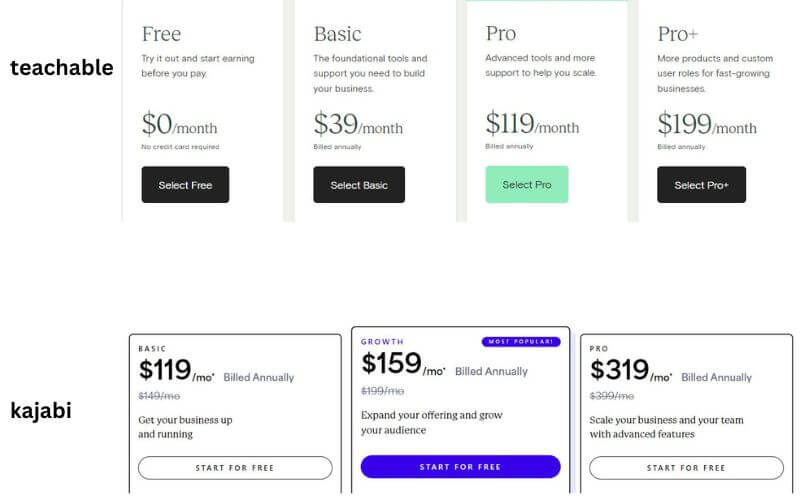
Effective Tools for Course Creation and Delivery
Teachable excels in providing practical tools for course creation and delivery. It offers essential features such as quizzes, course completion certificates, and a streamlined content upload process. These tools, while less extensive than Kajabi’s, meet the core needs of course creators focusing on content delivery and student engagement.
Responsive Customer Support
Another notable advantage of Teachable is its responsive customer support. Users of Teachable often praise the platform for its helpful support team, which is crucial for resolving any issues quickly and efficiently, a vital aspect for creators who may need more extensive technical expertise.
Limitations and Considerations
When evaluating the comparison between Kajabi and Teachable, it’s also essential to consider the limitations and considerations associated with each platform to make a well-informed decision.
Kajabi’s Limitations
Despite the comprehensive feature set of Kajabi, there are some things that could be improved and considered. Firstly, Kajabi’s pricing is notably higher than Teachable’s, which might be a barrier for those just starting out or with limited budgets. This makes it less accessible for beginners or small-scale course creators. Additionally, the complexity and abundance of features, while beneficial, can be overwhelming for some users, especially those who are new to online course platforms or prefer a more straightforward approach.
Teachable’s Considerations
On the other hand, Teachable, while excelling in simplicity and user-friendliness, has its own set of limitations. It needs the advanced marketing and automation tools that Kajabi offers, which can be a drawback for course creators looking to extensively market and scale their courses. Also, Teachable’s customization options for course and website design are more limited than Kajabi’s, which might be a concern for those who require extensive branding and customization.
Technical Support and Learning Curve
Another consideration is the level of technical support and the learning curve associated with each platform. Kajabi offers extensive resources and support but requires a steeper learning curve due to its complex features. In contrast, Teachable is easier to pick up but might require external tools and resources as your business grows and your needs become more sophisticated.
Scalability and Long-Term Growth
Finally, consider the scalability and long-term growth potential when choosing between Kajabi and Teachable. Kajabi’s extensive tools and integrations offer greater scalability for a growing business. At the same time, Teachable, though excellent for starting and mid-level course creators, may present limitations for large-scale operations.
User Reviews and Testimonials
Kajabi
Positive Aspects:
- Kajabi is praised for its templates, organization, and layout, making content consumption easy for users.
- Users find it user-friendly and supportive and appreciate the well-structured “Kajabi University.”
- It offers an easy-to-use, comprehensive education platform for both educators and students.

Areas for Improvement:
- Some users feel Kajabi could improve in landing pages, checkouts, and membership programs.
- Page editing is considered good but could be enhanced with more flexible features like full-range drag & drop.
Teachable
Positive Aspects:
- Users have had great experiences with Teachable, citing its familiarity and excellent customer service team.
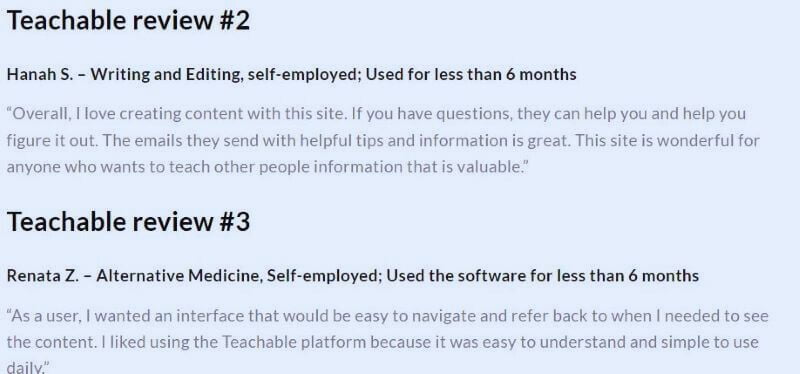
Areas for Improvement and Concerns:
- Teachable is criticized for lacking a drag-and-drop landing page builder and for its generic templates, making it challenging to create sleek-looking landing pages.
- A significant concern raised by a user was regarding the “Unlimited Everything” plan. The user reported being contacted by Teachable’s business support for overusing the plan and faced what they described as blackmail and harassment, leading to their decision to switch platforms.
- This user also pointed out false advertising of services by Teachable and recommended against using the platform.
- Another comparison made by a user highlighted that Thinkific, an alternative platform, was significantly better than Teachable in terms of user interface and customer service, implying Teachable’s shortcomings in these areas.
Final Thoughts on Kajabi vs Teachable
After thorough analysis and comparison, it’s clear that both Kajabi and Teachable have their unique strengths and ideal use cases. Your choice between the two should be influenced by your specific needs, skills, and goals
We’ve conducted a detailed comparison, examining features, user experiences, pricing, and real-life testimonials. Each platform has its unique strengths and limitations.
Kajabi excels with its all-in-one approach, offering extensive features for those looking to create, market, and sell their courses comprehensively.
On the other hand, Teachable shines with its user-friendly interface and straightforward functionality, making it an excellent choice for beginners or those who prioritize ease of use over complex functionality.
Ultimately, your decision should hinge on your individual requirements, goals, and level of expertise in digital course creation and marketing. Are you seeking an all-encompassing platform that offers a wide range of marketing tools and customization options? Kajabi might be your go-to choice. Or are you starting out and prefer a more straightforward, budget-friendly platform? Then, Teachable could be the ideal fit for you.
Remember, the success of your online course does not solely depend on the platform you choose but also on the quality of your content, your marketing strategies, and your engagement with your audience. Both Kajabi and Teachable offer the tools to make your course a success – the key is to leverage these tools effectively to match your vision and strategy.
In your quest to find the perfect platform for your online courses, weigh your options carefully, consider your long-term goals, and choose a platform that meets your current needs and supports your future growth. Whether it be Kajabi or Teachable, your choice should empower you to create, teach, and thrive in the ever-evolving world of online education.
Frequently Asked Questions (FAQs)
Which platform is better for beginners?
Teachable is often recommended for beginners due to its user-friendly interface and straightforward course creation process. It’s less overwhelming than Kajabi, making it a good choice for those just starting out.
Can I migrate my existing courses from another platform to either Kajabi or Teachable?
Both Kajabi and Teachable support course migration from other platforms. However, the process can vary in complexity, and it’s advisable to check each platform’s guidelines or seek support for a smooth transition.
How do the payment processing fees compare between the two platforms?
Teachable includes payment processing fees in its plans, which can vary based on the plan chosen. Kajabi, on the other hand, does not charge additional transaction fees but recommends using a payment gateway like Stripe or PayPal, which may have their own fees.
Are there any limitations on the number of students or courses I can have on Kajabi and Teachable?
Teachable offers unlimited students and courses on all its plans. Kajabi, while also offering unlimited courses, has limitations on the number of active members and products based on the plan you choose.
Do Kajabi and Teachable offer any free trial period?
Yes, both platforms offer a free trial period. Teachable provides a 14-day free trial, and Kajabi offers a 14-day free trial as well, giving you an opportunity to explore their features before committing to a plan.
Which platform offers better marketing tools?
Kajabi is known for its advanced marketing tools, including email marketing, sales funnels, and automation capabilities. Teachable offers basic marketing tools but lacks the comprehensive suite provided by Kajabi.
Can I create membership sites on both Kajabi and Teachable?
Kajabi offers robust capabilities for creating membership sites, which is part of its all-in-one platform. Teachable allows for course bundling and subscriptions, which can be used to create a form of membership experience. Still, it’s not as extensive as Kajabi.
Is customer support readily available on both platforms?
Yes, both Kajabi and Teachable offer customer support. However, the availability and response times can vary based on the plan you are on. Generally, users report satisfactory support experiences with both platforms
Additional Resources and Further Reading
If you want to gain a deeper understanding of Kajabi or Teachable, the following are additional resources and materials focusing on a tool that can be integrated with these platforms:

